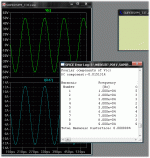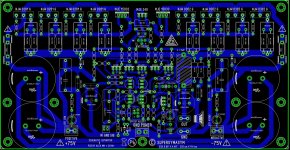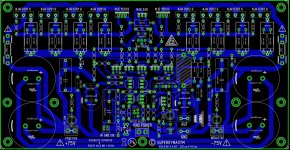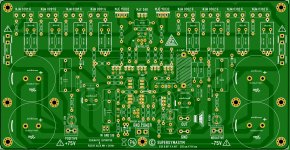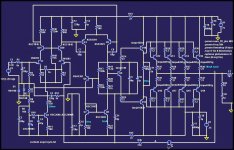Rafael thanks. This means that actual stability in a real circuit, thermal issues and sonic quality have not been verified. I am inclined towards OS' Mosfet triple. However, I still do have interest in your circuit for BJT outputs.
Rafael didn't mention it, but a problem we have here in Brazil is getting power MOSFETs and fets in general. He certainly used BJTs because of that.
Another interesting thing is how the Supersym resembles the Electrocompaniet Ampliwire 100. Have a look:
Attachments
Last edited:
Rafael thanks. This means that actual stability in a real circuit, thermal issues and sonic quality have not been verified. I am inclined towards OS' Mosfet triple. However, I still do have interest in your circuit for BJT outputs.
Hi Samuel
The stability thermal should not be problem, even if some variation (Ic) should not be unstable, the amp has a good phase margin. The amp is class AB, monitoring of VBE multiplier, not critical...which could have a problem with square wave in real circuit, but I added base stoppers for "security" (in simulator are not needed)
I no have experience with Mosfet, but for this amp with this power do not seem to benefit, the four pairs BJTs reduce distortion in output, but could use them in the driver and triple output would not be necessary.
Sound...well...I would have to several good amps to compare, but I not have.
What I can provide are technical data, distortion in open loop <1% (33dB negative feedback, distortion in closed loop is 0,01% MAX) that associated the slew rate (90 Vus), the amp should have low distortion TIM, DIM, AIM and PIM. The high damping factor should make bass be "dried", but with depth.
Mids and treble should be well defined, the amp's should not get along with highly reactive loads.
Rafael didn't mention it, but a problem we have here in Brazil is getting power MOSFETs and fets in general. He certainly used BJTs because of that.
Another interesting thing is how the Supersym resembles the Electrocompaniet Ampliwire 100. Have a look:
I used BJTs because supersym used BJTs, my project also uses BJTs (are easy to find). Mosfets, I not tried find in electronics here in the country, what is hard to find are good BJTs TO-126
Electrocompaniet is a project High-End, a little above of modest amplifiers that Topic, that at most could be classified as Hi-Fi
Last edited:
Referring to the post where I mentioned my new triple .. I did build it as well as simulate it . (those 2 things usually happen simultaniously ) I chose to use BJT's because when I do the final version, 5 pair of the 21193/4,s or the 0281/0302's are dirt cheap here. (2$ and $1.40 ea.) . With these OP's , especially the first ones , 10A of DC SOA @ 80V is all mine. 20$ a channel for that much "oomph" is a deal.
I have been using the amps in post #1 as the test bed for ,1. mosfet OP's.. 2. input stage / vas mod's and 3. ,the new T3T triple(BJT). The last mod (the triple) did the most for the sound , the bass especially. I have ran each variant that I have offered here for 2 weeks plus (movies / parties / general listening). My final choice is the last one (supersym -T3T) . It has by far the best value vs. sound and is ridiculously stable as well.
What has totally amazed me is that I have not burned one out yet. I am running on just 3 pair OP's with 1 OP pair as the drivers into 4R loads at hefty volumes.(shaking the house/windows) NO
 , not even close.
, not even close.
OS
I have been using the amps in post #1 as the test bed for ,1. mosfet OP's.. 2. input stage / vas mod's and 3. ,the new T3T triple(BJT). The last mod (the triple) did the most for the sound , the bass especially. I have ran each variant that I have offered here for 2 weeks plus (movies / parties / general listening). My final choice is the last one (supersym -T3T) . It has by far the best value vs. sound and is ridiculously stable as well.
What has totally amazed me is that I have not burned one out yet. I am running on just 3 pair OP's with 1 OP pair as the drivers into 4R loads at hefty volumes.(shaking the house/windows) NO

 , not even close.
, not even close.OS
Last edited:
OS, since you are impressed with using the 3T3 triple (BJT) for parties, why not include short-circuit protection as insurance and perhaps, over-current protection? Soft start, DC detection, thermal cut-off etc., can be added with an auxillary circuit. Very, very good work OS.
By sam J. - Soft start, DC detection, thermal cut-off etc., can be added with an auxillary circuit. Very, very good work OS.
I already have the soft start , which I designed on it's own board with a external trigger connect. I also am using 8A rail fuses to keep from
 making fires.
making fires.I did drink the "grog"
 one night and shorted an amp (big spark) . NO blown OP's !!! , all it did was blow the 8A'ers. when I do the final one a month from now , it will have the higher current OP's .... this calls for some protection!
one night and shorted an amp (big spark) . NO blown OP's !!! , all it did was blow the 8A'ers. when I do the final one a month from now , it will have the higher current OP's .... this calls for some protection!It was mentioned that this amp is like the Electrocompaniet. It IS !! I did look at a half dozen older schema's and there were great similarities (and differences).
I also saw some one mention a lower CDOM. No problem, 47p and 82-100R LTP Re's will give the same 800khz UGP. Here is the "final" (yeah ,right!), Spice sim for this nice amp ... be sure to extract the .txt file to the same place as the .asc (models are there).
thanx , OS
Attachments
by eddelarue - the simulation presents lower distortion with R12=390R and R46=12k.
Yes , I submitted the simulation with class A bias ... r21 = 300R , it should be 485R (trimmer) , which equates to 80ma / per Op device. Changing R12/46 should be no problem either , I used a 680R/22k combo (better thd as well)...for the same gain plot response. All will equate to roughly 32db gain , but one might adjust the LTP degeneration to assure enough phase margin (stability is paramount).
OS
Edit , another point to make... the .0008 - .001 % is ALL loads and ALL frequencies and is obtained between 70 - 110ma per device (NJW21193/4 or NJW0302/0281) . If you increase the self type 3 driver current (R50/51 = 22R) , total distortion will not drop significantly, but H2 will be the only remaining component (H3/5/7 just "disappear")
Last edited:
Edit , another point to make... the .0008 - .001 % is ALL loads and ALL frequencies and is obtained between 70 - 110ma per device (NJW21193/4 or NJW0302/0281) . If you increase the self type 3 driver current (R50/51 = 22R) , total distortion will not drop significantly, but H2 will be the only remaining component (H3/5/7 just "disappear")[/QUOTE]
Is it better, no ?!!
Is it better, no ?!!
Is it better, no ?!!
Some say that is better (no H5/7), even mr. John Curl. 5th and 7th harmonic distortion products are said to be the main players in "harshness" or a "metallic sound". On the latest triple with the driver bias cranked up, a subtle smoothness appears that is missing with the standard 2 stage EF.
Another factor is the biasing , the T3T can stay within 1/2 mv Re on the Op's indefinitely. For these small improvements - 5 components... and it is as stable as an EF type 2. One could just build a standard DX type amp or self amp with a standard OPS , but there would be many limitations. BETTER ???, that is totally up to the application.
OS
Hi Alex MM !!Hi MJL 21193 ,
I made for you the layout ,
I think It's acceptable
http://i43.tinypic.com/2cx6d7n.jpg
Regards Alex mm .

PCB made great!
Where can you find a shematic (circuit) of this amplifier?
http://i43.tinypic.com/2cx6d7n.jpg
thanks and cheers !
Last edited:
Note, that DGS for the sk170 is the same pin out as a BC which is cbe.
Just swap them and adjust current and Degen Resistor value as necessary.
But do check Vds !!!!! The BC can take 30Vce to 60Vce depending on model fitted.
The sk170 is limited to MUCH lower voltages, aim for <20Vds and preferably around 8Vds to 12Vds.
Just swap them and adjust current and Degen Resistor value as necessary.
But do check Vds !!!!! The BC can take 30Vce to 60Vce depending on model fitted.
The sk170 is limited to MUCH lower voltages, aim for <20Vds and preferably around 8Vds to 12Vds.
... OK @ maxpou attached you have PCB modified version ...
Alex
Alex
Attachments
Gerbers files for your supersym and The MONGREL (supersym II)I would like the Gerbers
I would like the Gerbers files for your supersym and The MONGREL (supersym II)
amplifiers so that I can order several sets for building and testing. I you offer a group
buy for either of these amplifiers, let me know. I can either have them done at a
vendor, using the Gerbers files, or purchase them via a group buy. Let me know.
I would like the Gerbers files for your supersym and The MONGREL (supersym II)
amplifiers so that I can order several sets for building and testing. I you offer a group
buy for either of these amplifiers, let me know. I can either have them done at a
vendor, using the Gerbers files, or purchase them via a group buy. Let me know.
- Status
- This old topic is closed. If you want to reopen this topic, contact a moderator using the "Report Post" button.
- Home
- Amplifiers
- Solid State
- Symasym - the next generation (supersym)
